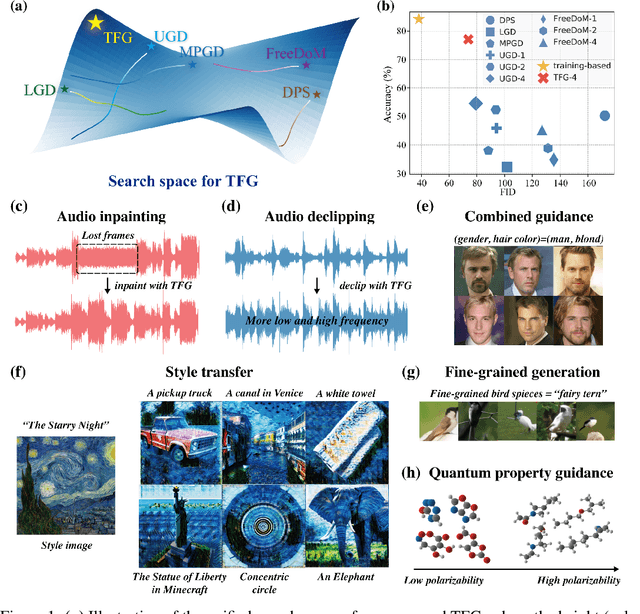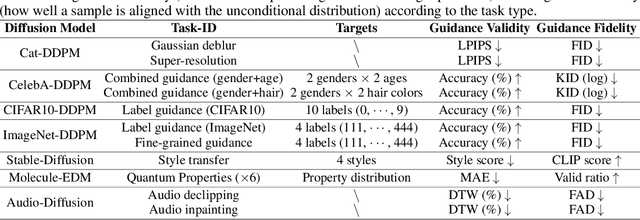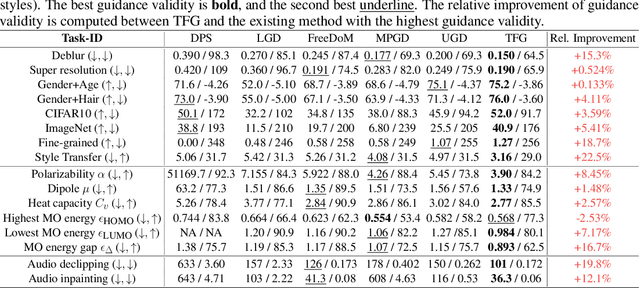Sheng Liu
MedReason: Eliciting Factual Medical Reasoning Steps in LLMs via Knowledge Graphs
Apr 01, 2025Abstract:Medical tasks such as diagnosis and treatment planning require precise and complex reasoning, particularly in life-critical domains. Unlike mathematical reasoning, medical reasoning demands meticulous, verifiable thought processes to ensure reliability and accuracy. However, there is a notable lack of datasets that provide transparent, step-by-step reasoning to validate and enhance the medical reasoning ability of AI models. To bridge this gap, we introduce MedReason, a large-scale high-quality medical reasoning dataset designed to enable faithful and explainable medical problem-solving in large language models (LLMs). We utilize a structured medical knowledge graph (KG) to convert clinical QA pairs into logical chains of reasoning, or ``thinking paths'', which trace connections from question elements to answers via relevant KG entities. Each path is validated for consistency with clinical logic and evidence-based medicine. Our pipeline generates detailed reasoning for various medical questions from 7 medical datasets, resulting in a dataset of 32,682 question-answer pairs, each with detailed, step-by-step explanations. Experiments demonstrate that fine-tuning with our dataset consistently boosts medical problem-solving capabilities, achieving significant gains of up to 7.7% for DeepSeek-Ditill-8B. Our top-performing model, MedReason-8B, outperforms the Huatuo-o1-8B, a state-of-the-art medical reasoning model, by up to 4.2% on the clinical benchmark MedBullets. We also engage medical professionals from diverse specialties to assess our dataset's quality, ensuring MedReason offers accurate and coherent medical reasoning. Our data, models, and code will be publicly available.
VISO-Grasp: Vision-Language Informed Spatial Object-centric 6-DoF Active View Planning and Grasping in Clutter and Invisibility
Mar 16, 2025Abstract:We propose VISO-Grasp, a novel vision-language-informed system designed to systematically address visibility constraints for grasping in severely occluded environments. By leveraging Foundation Models (FMs) for spatial reasoning and active view planning, our framework constructs and updates an instance-centric representation of spatial relationships, enhancing grasp success under challenging occlusions. Furthermore, this representation facilitates active Next-Best-View (NBV) planning and optimizes sequential grasping strategies when direct grasping is infeasible. Additionally, we introduce a multi-view uncertainty-driven grasp fusion mechanism that refines grasp confidence and directional uncertainty in real-time, ensuring robust and stable grasp execution. Extensive real-world experiments demonstrate that VISO-Grasp achieves a success rate of $87.5\%$ in target-oriented grasping with the fewest grasp attempts outperforming baselines. To the best of our knowledge, VISO-Grasp is the first unified framework integrating FMs into target-aware active view planning and 6-DoF grasping in environments with severe occlusions and entire invisibility constraints.
OLMD: Orientation-aware Long-term Motion Decoupling for Continuous Sign Language Recognition
Mar 11, 2025Abstract:The primary challenge in continuous sign language recognition (CSLR) mainly stems from the presence of multi-orientational and long-term motions. However, current research overlooks these crucial aspects, significantly impacting accuracy. To tackle these issues, we propose a novel CSLR framework: Orientation-aware Long-term Motion Decoupling (OLMD), which efficiently aggregates long-term motions and decouples multi-orientational signals into easily interpretable components. Specifically, our innovative Long-term Motion Aggregation (LMA) module filters out static redundancy while adaptively capturing abundant features of long-term motions. We further enhance orientation awareness by decoupling complex movements into horizontal and vertical components, allowing for motion purification in both orientations. Additionally, two coupling mechanisms are proposed: stage and cross-stage coupling, which together enrich multi-scale features and improve the generalization capabilities of the model. Experimentally, OLMD shows SOTA performance on three large-scale datasets: PHOENIX14, PHOENIX14-T, and CSL-Daily. Notably, we improved the word error rate (WER) on PHOENIX14 by an absolute 1.6% compared to the previous SOTA
OTLRM: Orthogonal Learning-based Low-Rank Metric for Multi-Dimensional Inverse Problems
Dec 15, 2024



Abstract:In real-world scenarios, complex data such as multispectral images and multi-frame videos inherently exhibit robust low-rank property. This property is vital for multi-dimensional inverse problems, such as tensor completion, spectral imaging reconstruction, and multispectral image denoising. Existing tensor singular value decomposition (t-SVD) definitions rely on hand-designed or pre-given transforms, which lack flexibility for defining tensor nuclear norm (TNN). The TNN-regularized optimization problem is solved by the singular value thresholding (SVT) operator, which leverages the t-SVD framework to obtain the low-rank tensor. However, it is quite complicated to introduce SVT into deep neural networks due to the numerical instability problem in solving the derivatives of the eigenvectors. In this paper, we introduce a novel data-driven generative low-rank t-SVD model based on the learnable orthogonal transform, which can be naturally solved under its representation. Prompted by the linear algebra theorem of the Householder transformation, our learnable orthogonal transform is achieved by constructing an endogenously orthogonal matrix adaptable to neural networks, optimizing it as arbitrary orthogonal matrices. Additionally, we propose a low-rank solver as a generalization of SVT, which utilizes an efficient representation of generative networks to obtain low-rank structures. Extensive experiments highlight its significant restoration enhancements.
Learning Robust Grasping Strategy Through Tactile Sensing and Adaption Skill
Nov 13, 2024Abstract:Robust grasping represents an essential task in robotics, necessitating tactile feedback and reactive grasping adjustments for robust grasping of objects. Previous research has extensively combined tactile sensing with grasping, primarily relying on rule-based approaches, frequently neglecting post-grasping difficulties such as external disruptions or inherent uncertainties of the object's physics and geometry. To address these limitations, this paper introduces an human-demonstration-based adaptive grasping policy base on tactile, which aims to achieve robust gripping while resisting disturbances to maintain grasp stability. Our trained model generalizes to daily objects with seven different sizes, shapes, and textures. Experimental results demonstrate that our method performs well in dynamic and force interaction tasks and exhibits excellent generalization ability.
Multimodal Instruction Tuning with Hybrid State Space Models
Nov 13, 2024



Abstract:Handling lengthy context is crucial for enhancing the recognition and understanding capabilities of multimodal large language models (MLLMs) in applications such as processing high-resolution images or high frame rate videos. The rise in image resolution and frame rate substantially increases computational demands due to the increased number of input tokens. This challenge is further exacerbated by the quadratic complexity with respect to sequence length of the self-attention mechanism. Most prior works either pre-train models with long contexts, overlooking the efficiency problem, or attempt to reduce the context length via downsampling (e.g., identify the key image patches or frames) to decrease the context length, which may result in information loss. To circumvent this issue while keeping the remarkable effectiveness of MLLMs, we propose a novel approach using a hybrid transformer-MAMBA model to efficiently handle long contexts in multimodal applications. Our multimodal model can effectively process long context input exceeding 100k tokens, outperforming existing models across various benchmarks. Remarkably, our model enhances inference efficiency for high-resolution images and high-frame-rate videos by about 4 times compared to current models, with efficiency gains increasing as image resolution or video frames rise. Furthermore, our model is the first to be trained on low-resolution images or low-frame-rate videos while being capable of inference on high-resolution images and high-frame-rate videos, offering flexibility for inference in diverse scenarios.
Reducing Hallucinations in Vision-Language Models via Latent Space Steering
Oct 21, 2024Abstract:Hallucination poses a challenge to the deployment of large vision-language models (LVLMs) in applications. Unlike in large language models (LLMs), hallucination in LVLMs often arises from misalignments between visual inputs and textual outputs. This paper investigates the underlying mechanisms of hallucination, focusing on the unique structure of LVLMs that distinguishes them from large language models (LLMs). We identify that hallucinations often arise from the sensitivity of text decoders to vision inputs, a natural phenomenon when image encoders and text decoders are pre-trained separately. Inspired by this, we introduce Visual and Textual Intervention (VTI), a novel technique designed to reduce hallucinations by steering latent space representations during inference to enhance the stability of vision features. As a task-agnostic test-time intervention, VTI can be easily applied to any problem without additional cost. Extensive experiments demonstrate that it can effectively reduce hallucinations and outperform baseline methods across multiple metrics, highlighting the critical role of vision feature stability in LVLMs.
Similarity-Dissimilarity Loss with Supervised Contrastive Learning for Multi-label Classification
Oct 17, 2024Abstract:Supervised contrastive learning has been explored in making use of label information for multi-label classification, but determining positive samples in multi-label scenario remains challenging. Previous studies have examined strategies for identifying positive samples, considering label overlap proportion between anchors and samples. However, they ignore various relations between given anchors and samples, as well as how to dynamically adjust the weights in contrastive loss functions based on different relations, leading to great ambiguity. In this paper, we introduce five distinct relations between multi-label samples and propose a Similarity-Dissimilarity Loss with contrastive learning for multi-label classification. Our loss function re-weights the loss by computing the similarity and dissimilarity between positive samples and a given anchor based on the introduced relations. We mainly conduct experiments for multi-label text classification on MIMIC datasets, then further extend the evaluation on MS-COCO. The Experimental results show that our proposed loss effectively improves the performance on all encoders under supervised contrastive learning paradigm, demonstrating its effectiveness and robustness.
TFG: Unified Training-Free Guidance for Diffusion Models
Sep 24, 2024



Abstract:Given an unconditional diffusion model and a predictor for a target property of interest (e.g., a classifier), the goal of training-free guidance is to generate samples with desirable target properties without additional training. Existing methods, though effective in various individual applications, often lack theoretical grounding and rigorous testing on extensive benchmarks. As a result, they could even fail on simple tasks, and applying them to a new problem becomes unavoidably difficult. This paper introduces a novel algorithmic framework encompassing existing methods as special cases, unifying the study of training-free guidance into the analysis of an algorithm-agnostic design space. Via theoretical and empirical investigation, we propose an efficient and effective hyper-parameter searching strategy that can be readily applied to any downstream task. We systematically benchmark across 7 diffusion models on 16 tasks with 40 targets, and improve performance by 8.5% on average. Our framework and benchmark offer a solid foundation for conditional generation in a training-free manner.
MedTrinity-25M: A Large-scale Multimodal Dataset with Multigranular Annotations for Medicine
Aug 06, 2024Abstract:This paper introduces MedTrinity-25M, a comprehensive, large-scale multimodal dataset for medicine, covering over 25 million images across 10 modalities, with multigranular annotations for more than 65 diseases. These enriched annotations encompass both global textual information, such as disease/lesion type, modality, region-specific descriptions, and inter-regional relationships, as well as detailed local annotations for regions of interest (ROIs), including bounding boxes, segmentation masks. Unlike existing approach which is limited by the availability of image-text pairs, we have developed the first automated pipeline that scales up multimodal data by generating multigranular visual and texual annotations (in the form of image-ROI-description triplets) without the need for any paired text descriptions. Specifically, data from over 90 different sources have been collected, preprocessed, and grounded using domain-specific expert models to identify ROIs related to abnormal regions. We then build a comprehensive knowledge base and prompt multimodal large language models to perform retrieval-augmented generation with the identified ROIs as guidance, resulting in multigranular texual descriptions. Compared to existing datasets, MedTrinity-25M provides the most enriched annotations, supporting a comprehensive range of multimodal tasks such as captioning and report generation, as well as vision-centric tasks like classification and segmentation. Pretraining on MedTrinity-25M, our model achieves state-of-the-art performance on VQA-RAD and PathVQA, surpassing both multimodal large language models and other representative SoTA approaches. This dataset can also be utilized to support large-scale pre-training of multimodal medical AI models, contributing to the development of future foundation models in the medical domain.
 Add to Chrome
Add to Chrome Add to Firefox
Add to Firefox Add to Edge
Add to Edge